WWII letter to the parents of a crewman lost in air combat training:
"He did not lay down his life upon the field of battle, but his sacrifice is the same. He was preparing himself to defend those liberties and principles which had been taught to him from his early youth and which were a part of his very being. This may be small consolation to you in your bereavement, but you may well be proud both of his life and of his death."
Friends of the Wyoming Veterans Memorial Museum

B-24J 42-100023, lost on Casper Mountain, WY, June 17, 1944, Zorn crew
B-24D 41-28436
1st Lt. Donald Trail crew
lost December 6, 1944
Edgerton, Wyoming
The Pilot and Mission
Twenty two year-old 1st Lt. Donald Trail completed 33 combat missions as B-24 pilot with the 15th Air Force in Italy. On many occasions, his heavy bomber limped back from missions over Axis countries covered with flak damage. With that many missions, the Army rotated him back to the States for well-deserved R&R.
He could have spent his remaining military time in a much less demanding way. But instead, Trail volunteered to share his experience with fellow airmen who would be shortly facing the flak-filled skies in Europe. Such was his respect for his fellow airmen.
If anyone knew how to fly the B-24, it was Trail. He would become an instructor at Casper Army Air Base in 1944. If he could bring his combat crew safely home on fiery combat missions, then he could certainly handle a plane full of trainees in Wyoming.
Combat Training in Wyoming
1st Lt. Donald Trail arrived at Casper Army Air Base in 1944 not entirely sure of what lay ahead. Training would be on a 24-7 basis. If an airplane comes available at 3 AM, you grab your crew out of the barracks and head out to the practice bombing range.
Accidents were occurring at an alarming rate, due to many reasons. The quality of training was dicey. Unlike Trail, so many cockpit crew instructors had no combat training. Pilots were sent into Wyoming weather with only a few hours of pilot-in-command instrument time. Entire crews were lost on dark and stormy Wyoming nights due to loss of visual ground references, icing conditions, poor radio and navigational aids, and mechanical failures. The war effort meant moving men along fast in training, and quickly getting them into combat. Corners had to be cut.
The airplanes used for training were often high-hour, war-weary examples. Aircraft mechanics were in short supply and spread thin during the intense war years. Maintenace was always a worry.
The Ancient B-24D
As heavy bombers go, the B-24D was an antique airplane at this stage of the war. But Trail needed to get his trainees into the air, and he had no other choice. 2nd, Lt Norwood Sisson flew in the copilot's seat on this mission.
Flying north from the base, they quickly reached the Salt Creek oil field 40 miles away. Suddenly, the right engine lost power and became engulfed in flame. The pilots knew that if they didn't get the plane down quickly, the wing could burn off sending the plane spinning into the ground.
During 1944, ex-Wyoming Veterans Memorial Museum Director Joye Kading was working in the Base Commanders office where she could overhear radio communications. Many years later, she related her story to a museum volunteer.
Salt Creek oil field was a forest of metal oil production derricks. Before the plane got too low, Trail ordered the crew to bail out. Four crewmen bailed out, with one landing in a gas plant. All four were reported to be in satisfactory condition.
According to Kading, copilot Sisson was concerned about parachuting into a derrick, and he wouldn't go. The aircraft commander, Donald Trail, wouldn't leave the ship with a crewman still aboard, so he looked for a suitable crash-landing area.
After passing over the town of Edgerton, Trail banked the B-24D southeast toward a relatively flat area east of Highway 387. The aircraft was rapidly losing altitude, and the cockpit crew realized they would not survive a crash landing. Jumping was the only option. Trail and Sisson bailed out, only to perish because the aircraft was too low. Now abandoned, the aircraft crashed east of Highway 387, spreading wreckage along the base of a sandstone cliff.
In 2005, the Edgerton Cafe was the best restaurant between Casper and Gillette. It was owned by Jack and Verna Malson, lifetime residents of Edgerton. In a conversation with Jack and Verna over coffee in the restaurant, they told their story.
Jack was a young boy playing in his backyard when the burning B-24D passed directly over him. He ran up the highway to the site and found the two cockpit crew bodies lying near Highway 387. Verna was riding in the back seat of the family car returning from Casper when the distressed aircraft flew by very close. She could see clearly the right wing being on fire.
Evert Dewitt is caretaker of the Salt Creek Museum in Midwest. Evert had a friend whose father had a bulldozer service during World War II. The story was told to Evert about how the father and his bulldozer were called to the crash site to dig a trench and bury the wreckage of 41-28436. Friends will be doing more research on that information.
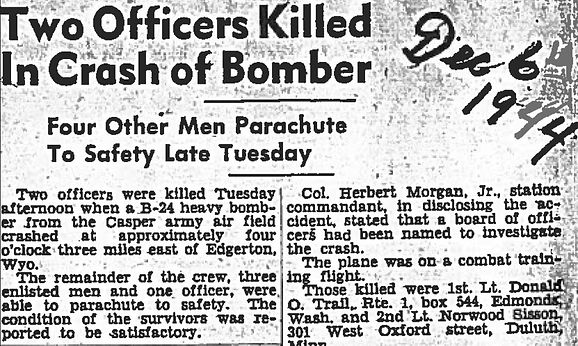
Domald Trail's Mother Bonnie Visits the Crash Site
1st Lt. Donald Trail grew up in Edmonds Washington. In 1946, two years after his death, his mother traveled to Wyoming to visit the Edgerton crash site. In the article below, she explains the good relationship garnered with Wyoming people.
Bonnie visited the site to make sure her son hadn't been
caught under the plane only to burn to death. The article below was provided by Pauline Schultz, founder of the Salt Creek Museum.
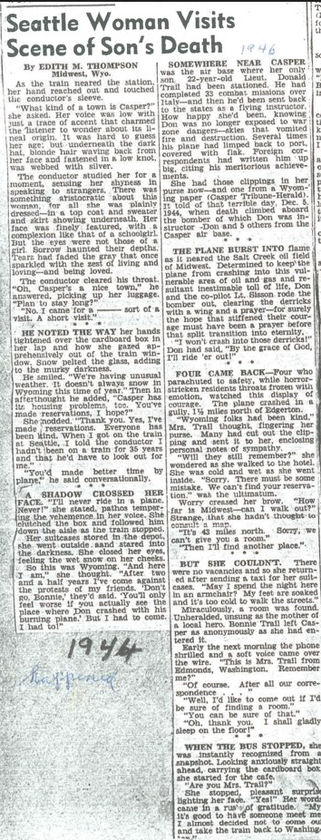
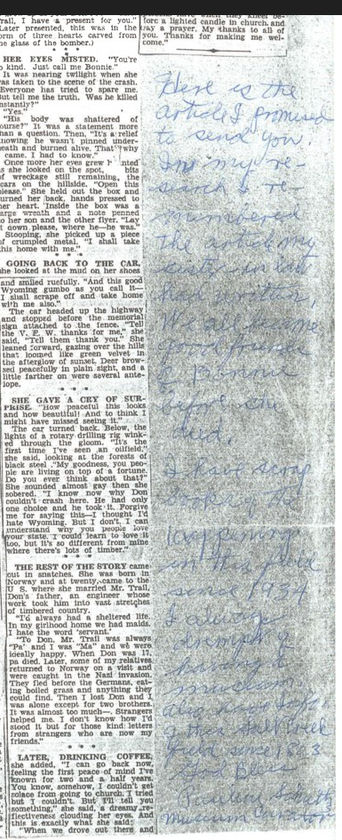
B-24D 41-28436 Site Photos
Photos of the crash site taken during a visit by researchers from the Colorado Historical Aviation Society (CAHS) in August 2020.
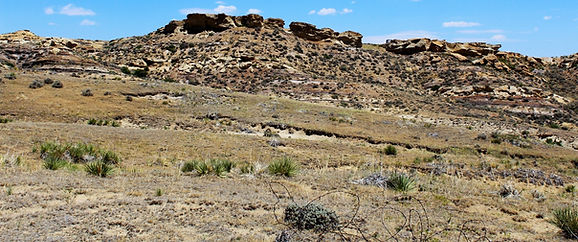
Crash site of B-24D 41-28436. This may have been the flat surface on which the cockpit crew was hoping for crash landing. Debris covers the foreground and in the gullies along the sandstone cliff.
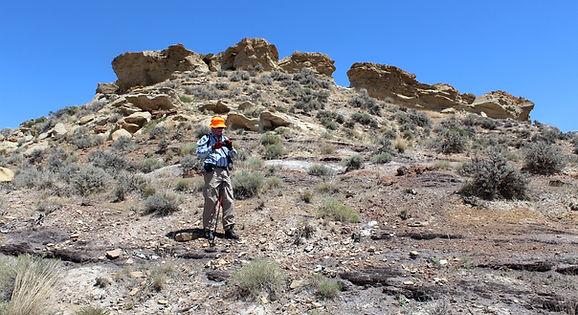
CAHS researcher studies crash debris along the cliff base.
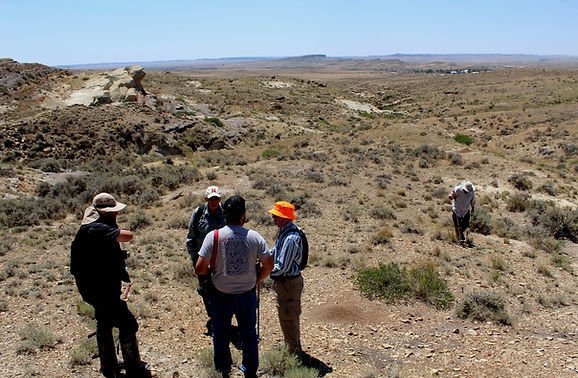
CAHS researchers planning their next steps in interpreting the crash site. Town of Edgerton is in the background.
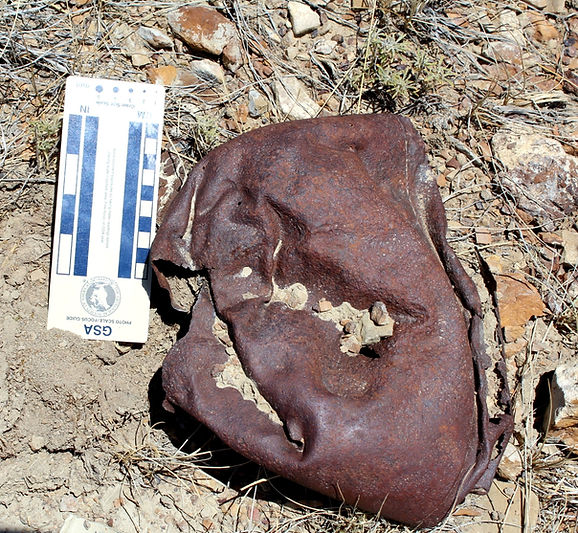
Crushed nose of a 100 lb. sand-filled practice bomb.
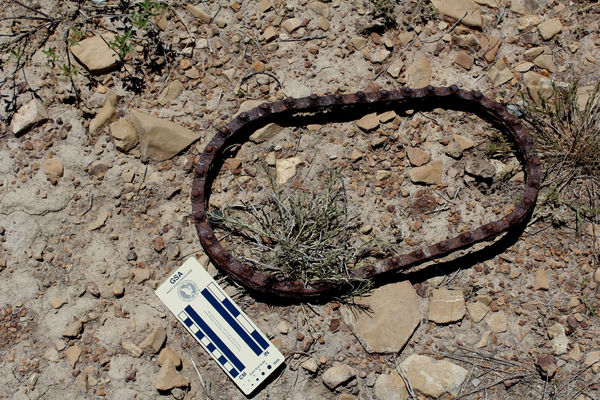
Window frame.
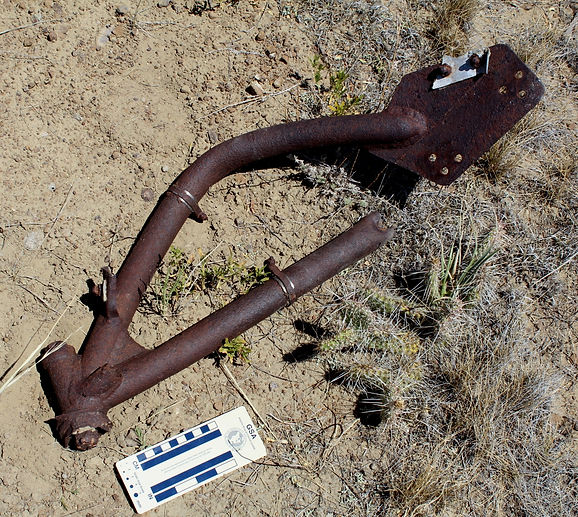
Landing gear component?
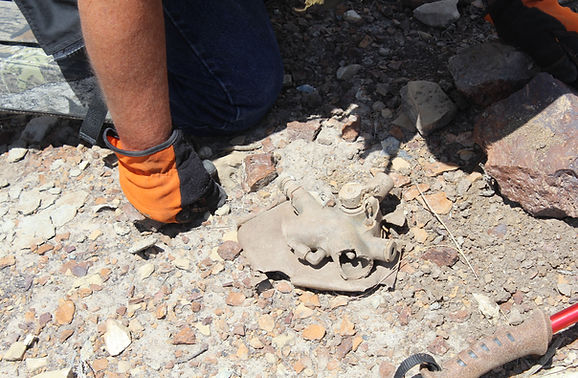
Oxygen or hydraulic component.
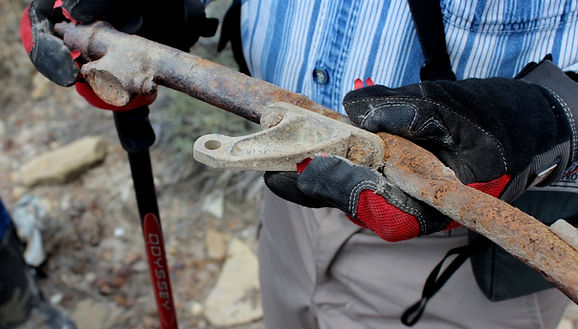
Control rod.

Propeller hub dug out of the ground after being buried for nearly 80 years. Ring gear fragment is part of the prop pitch control mechanism.
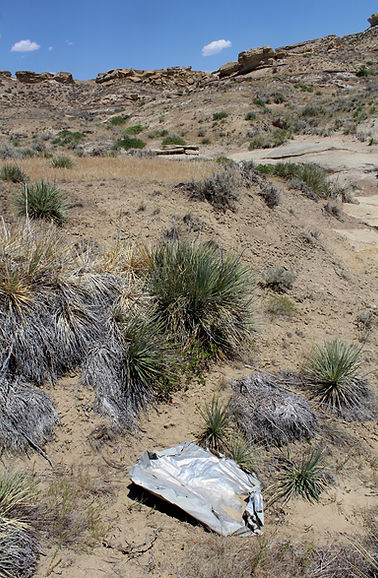
Sheet aluminum.
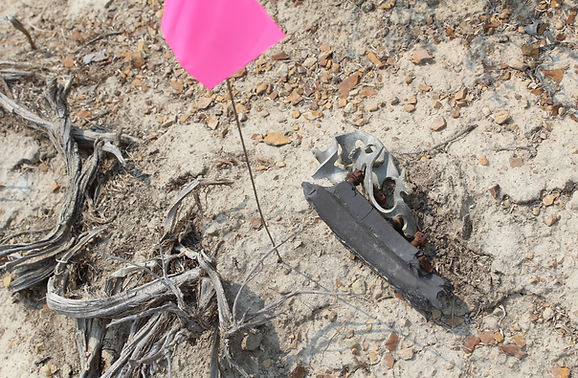
Aluminum casting
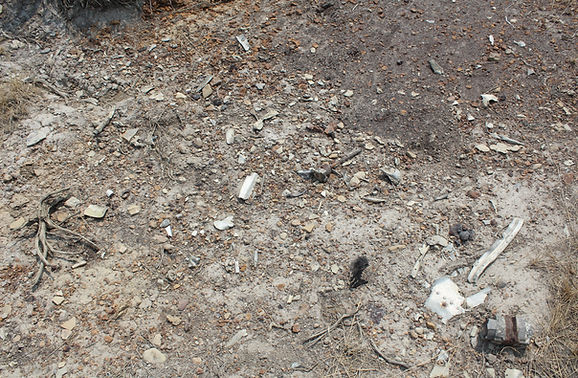
Debris field of small pieces.
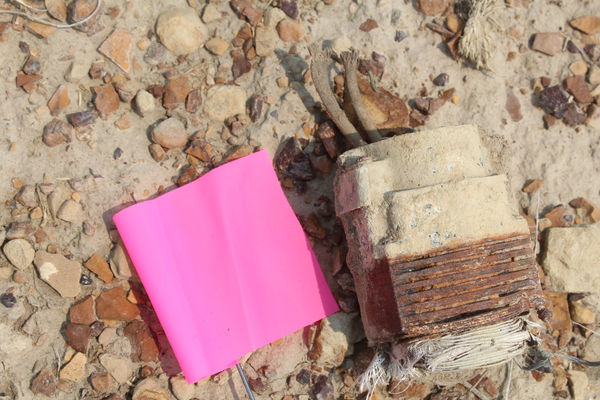
Heavy duty electrical component, possibly part of a magneto.
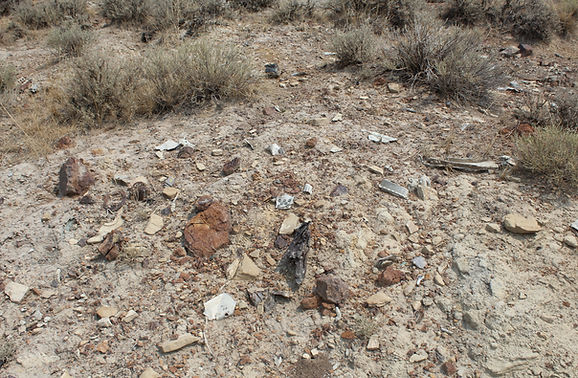
A debris field of small pieces.
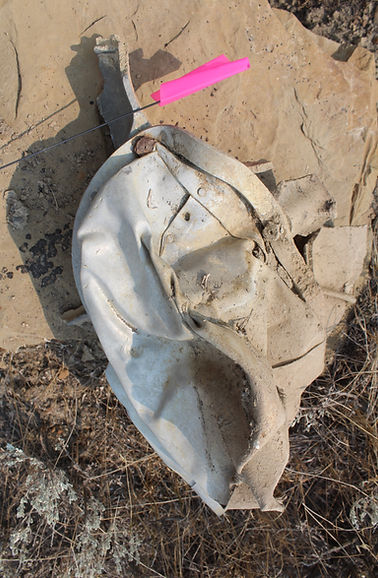
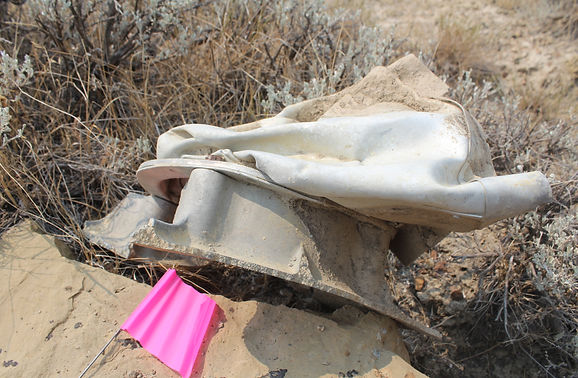
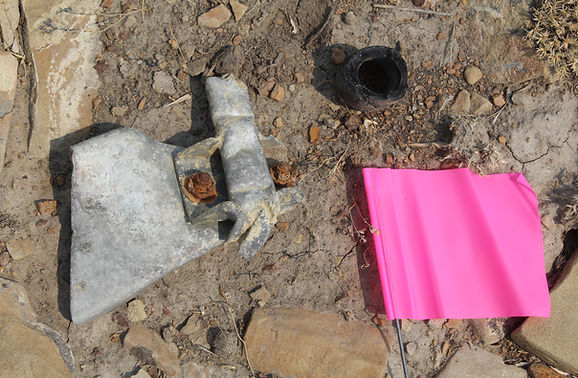
Feed-through bracket and rubber hose fragment.

Debris field of small pieces.
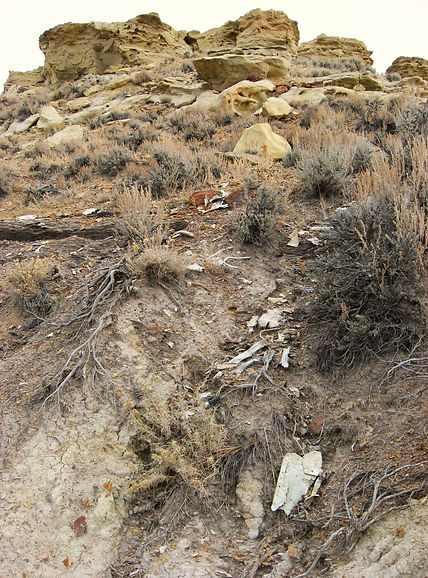
Crash debris washing down a gully. This suggests the airccraft may have hit close to the sandstone cliff.
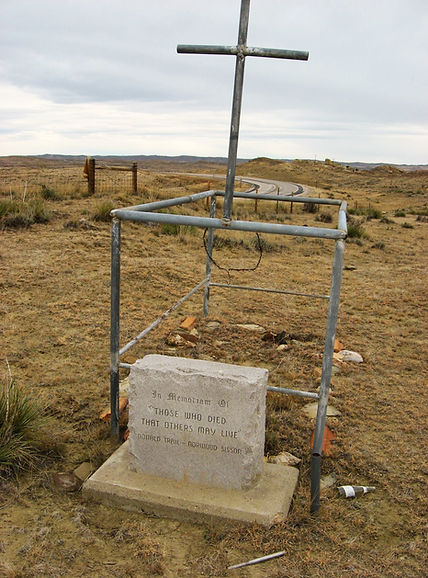
Memorial erected by the citizens of Edgerton. Highway 387 is in the background.
Memorial erected by the citizens of Edgerton. Highway 487 is in the background.
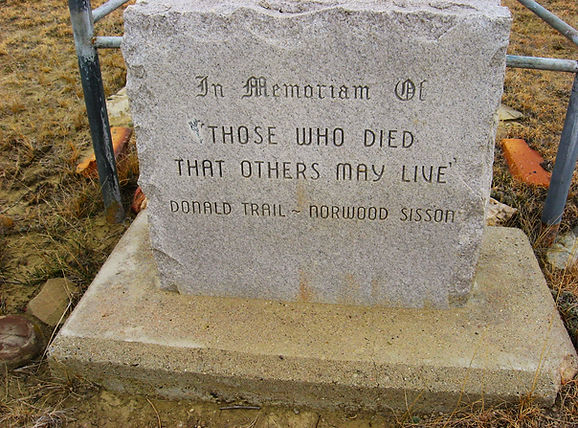
The citizens of Edgerton thought the reason why the cockpit crew stayed with the plane was to keep it from crashing into their town.